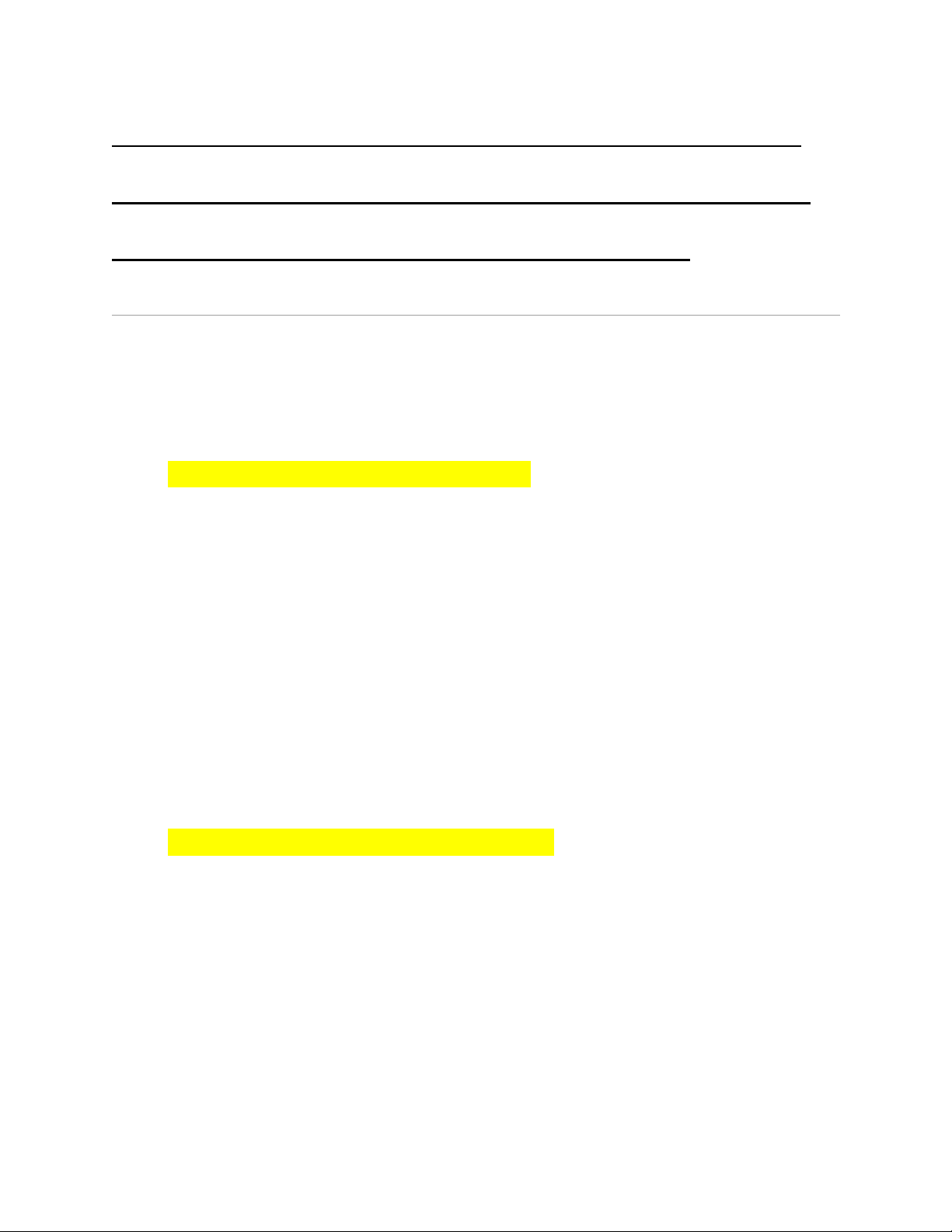
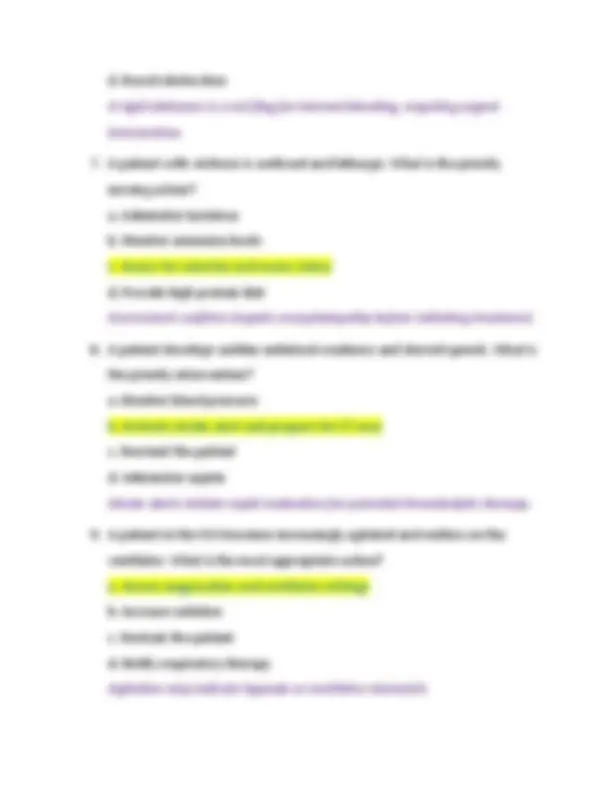
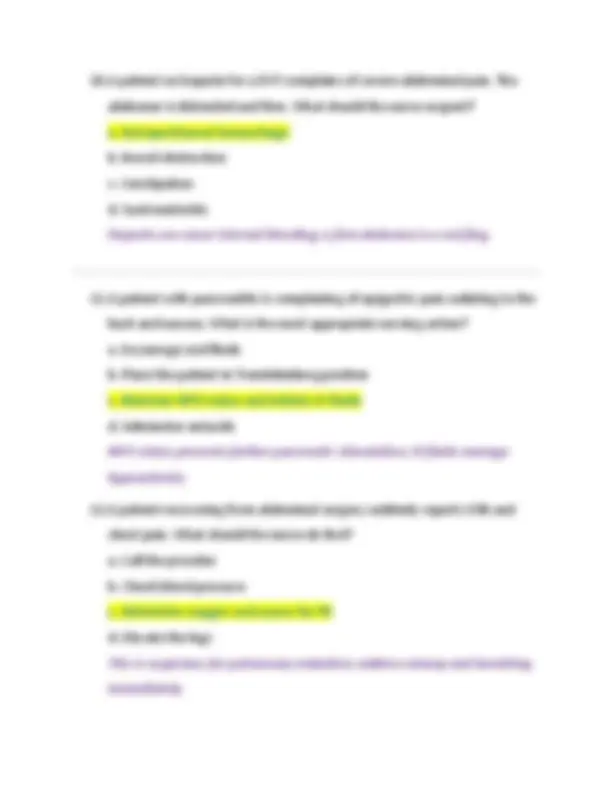
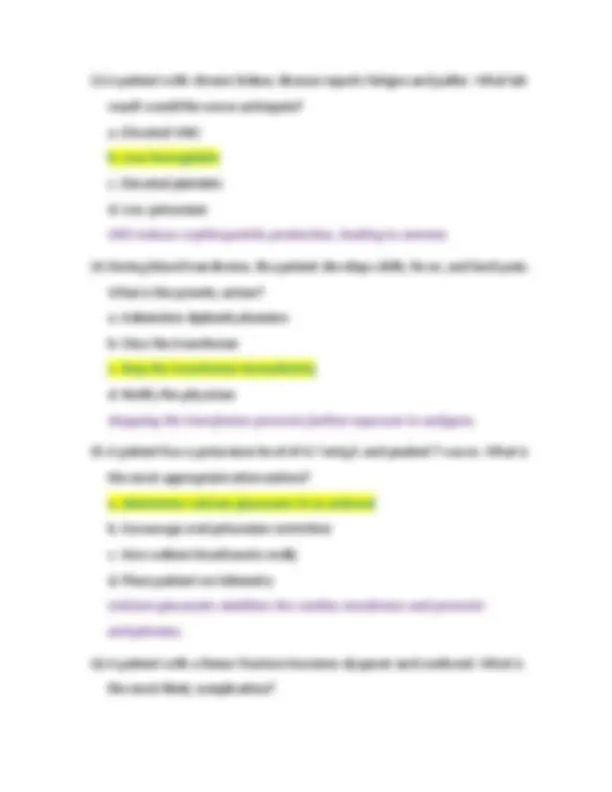
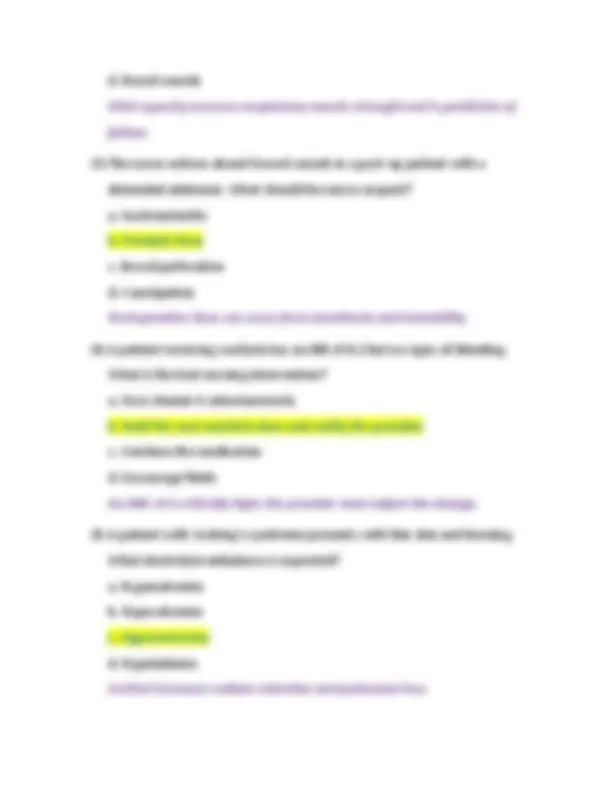
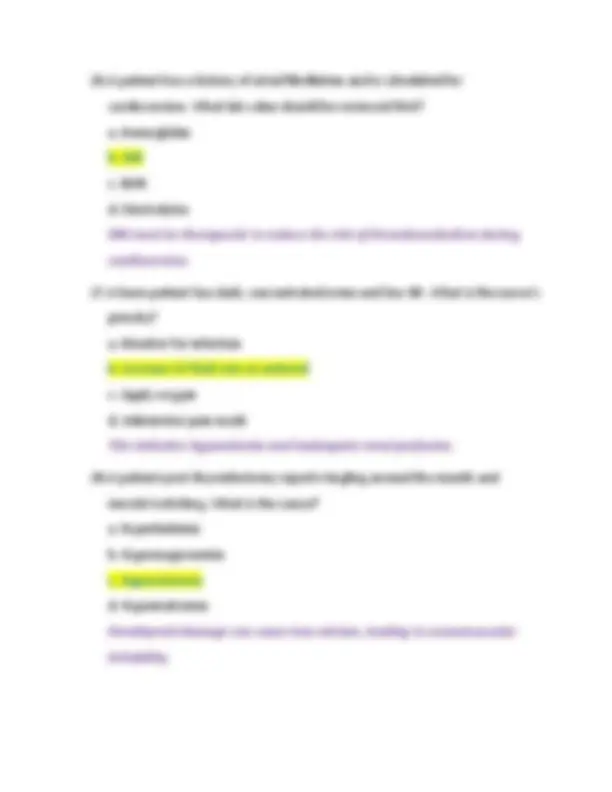
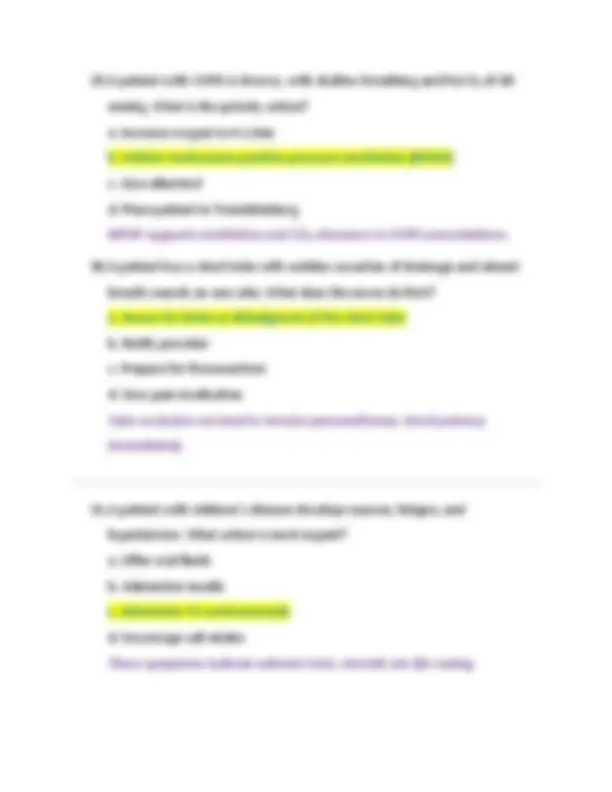
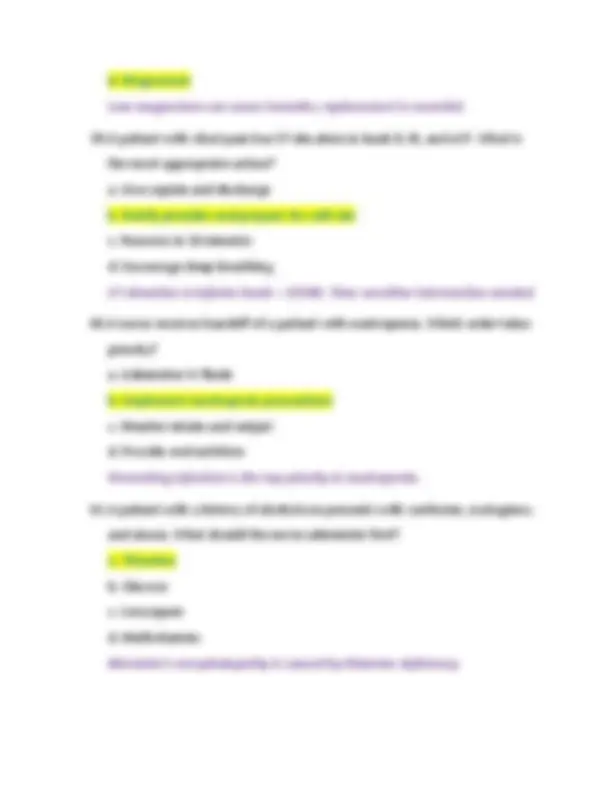
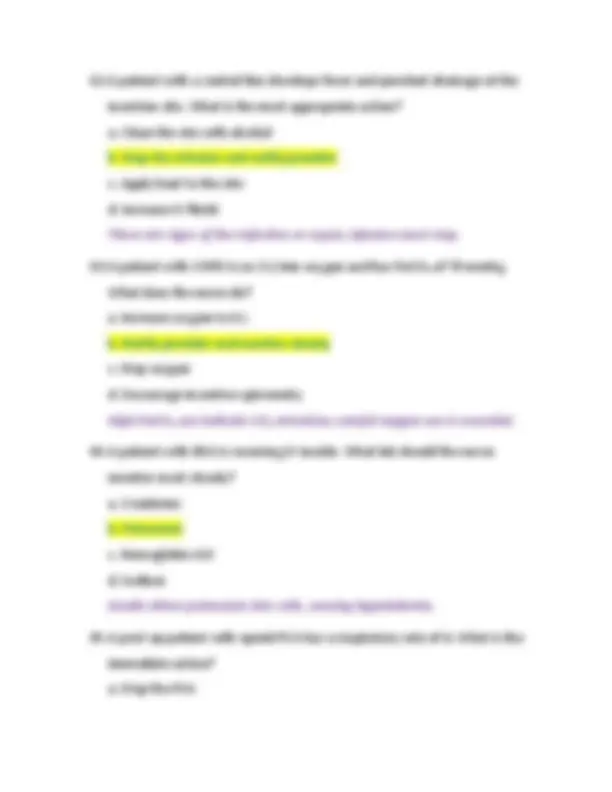
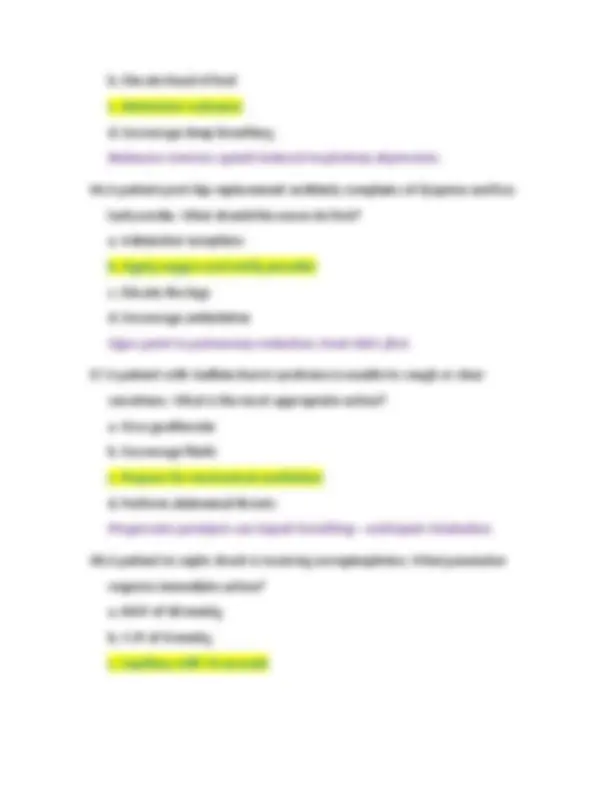
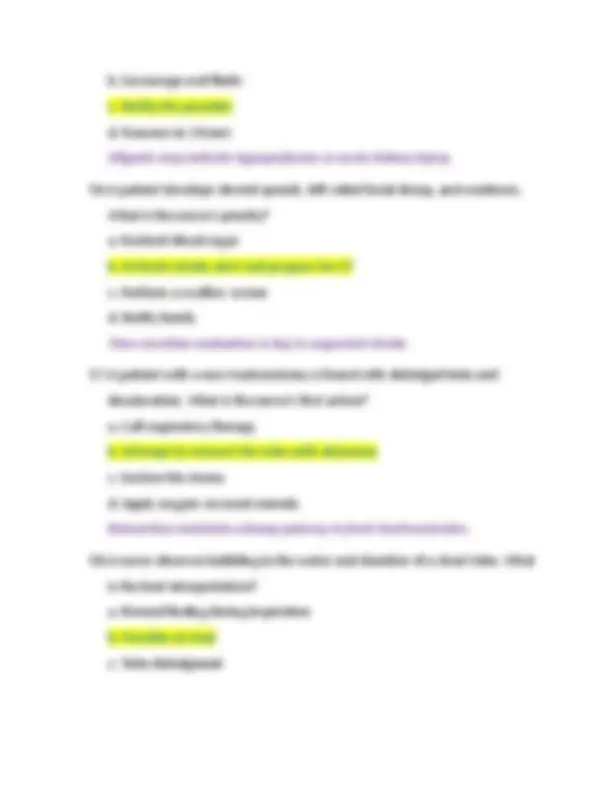
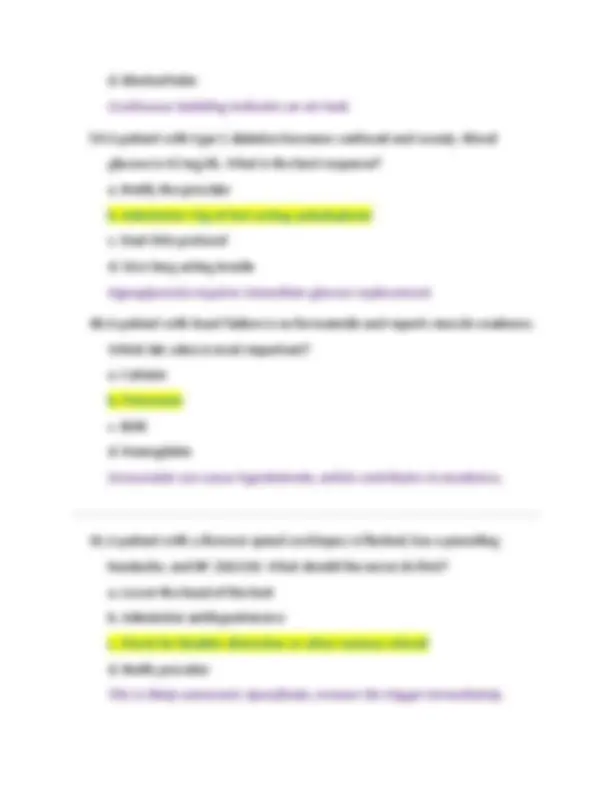
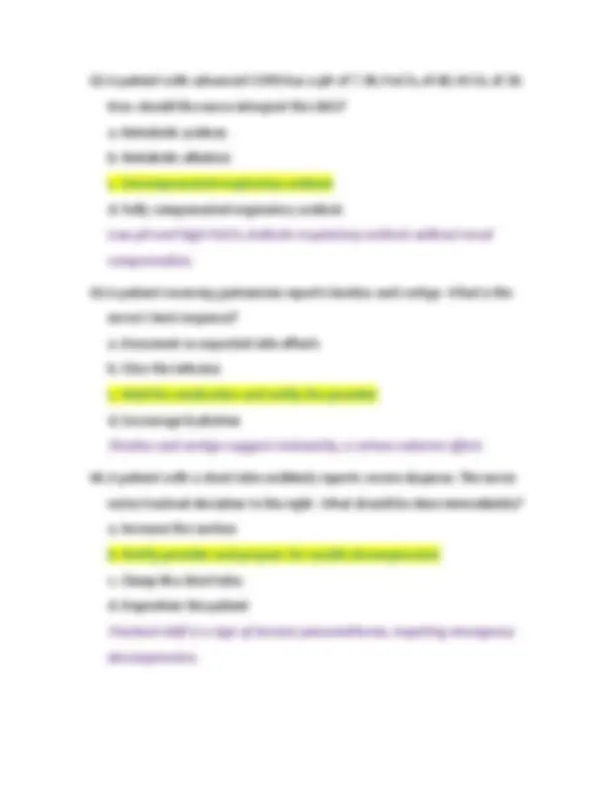
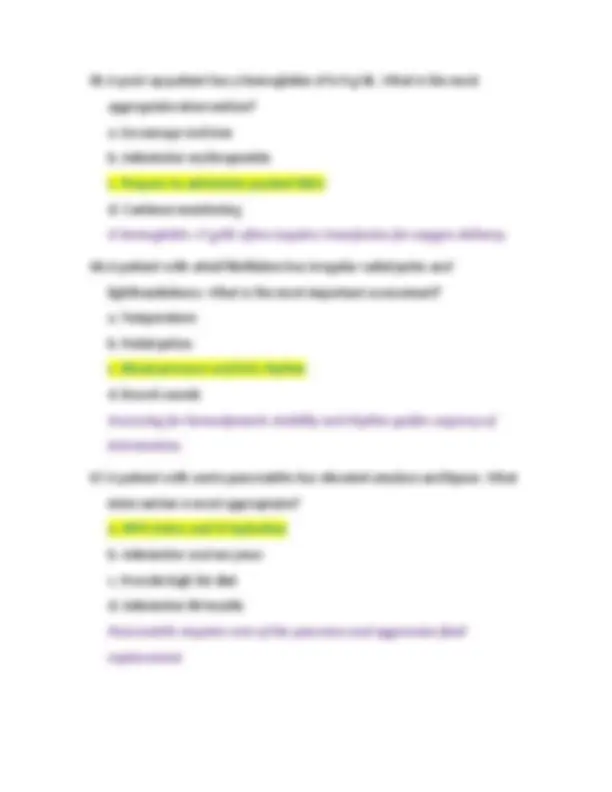
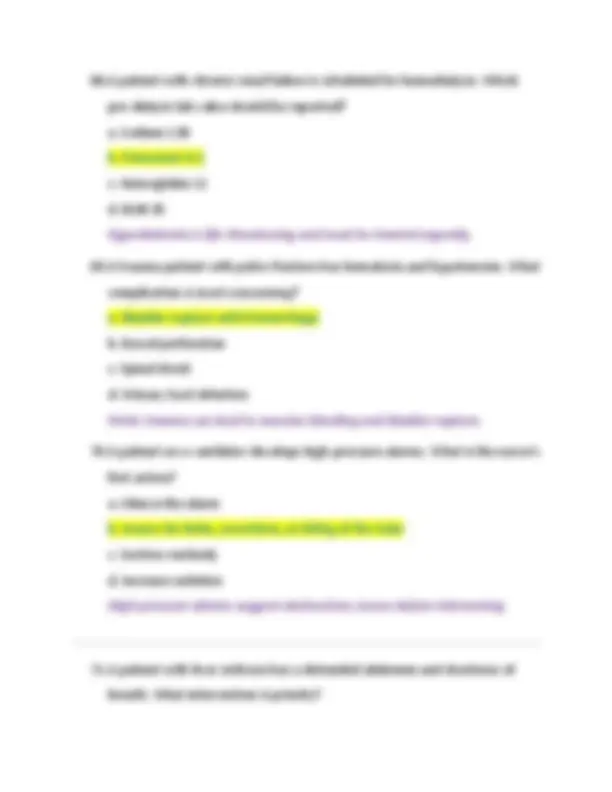
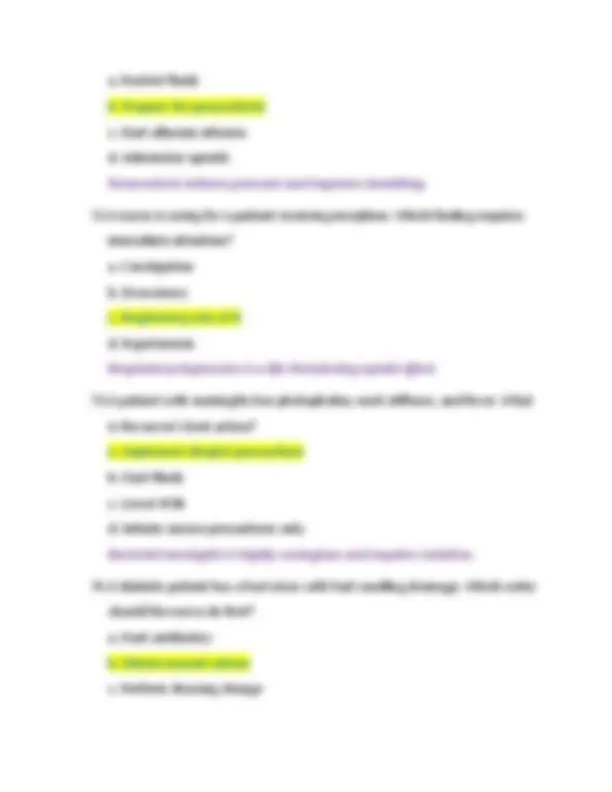
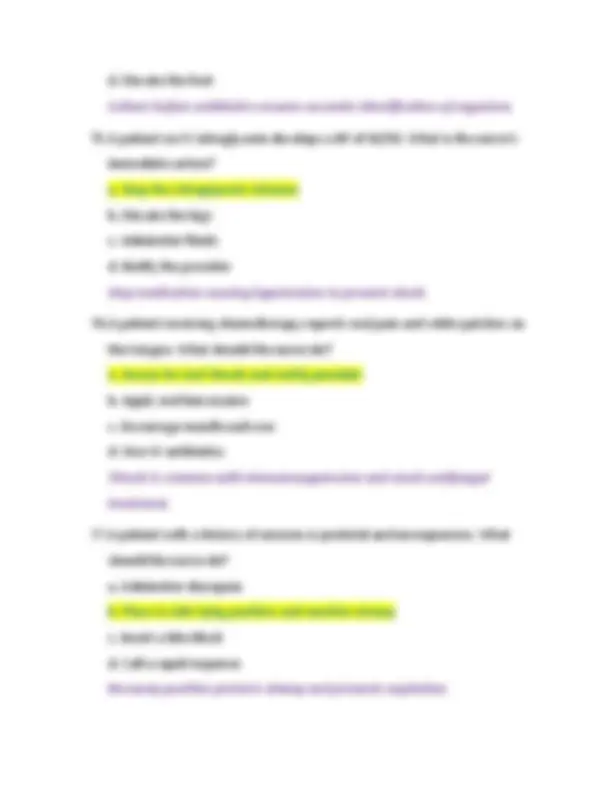
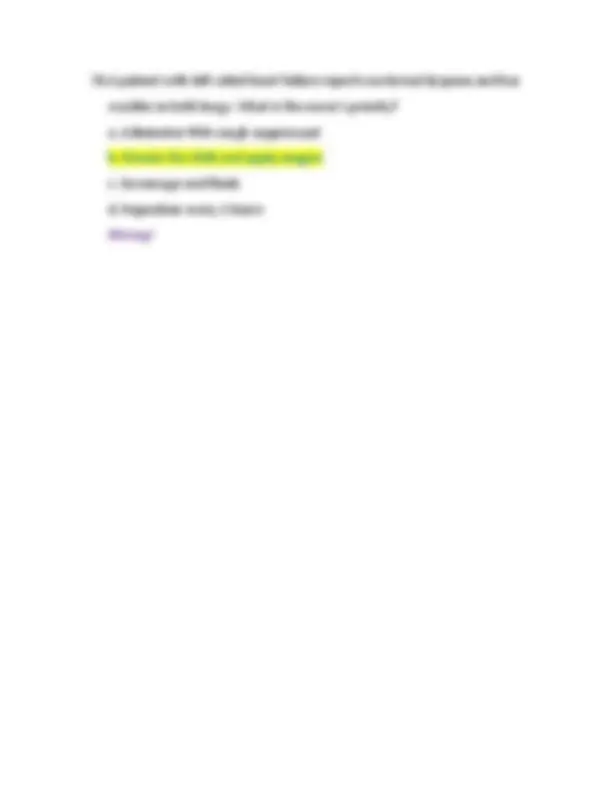


Study with the several resources on Docsity

Earn points by helping other students or get them with a premium plan


Prepare for your exams
Study with the several resources on Docsity

Earn points to download
Earn points by helping other students or get them with a premium plan
Community
Ask the community for help and clear up your study doubts
Discover the best universities in your country according to Docsity users
Free resources
Download our free guides on studying techniques, anxiety management strategies, and thesis advice from Docsity tutors
NSG 4513 Adult Health III Case-Based Simulation Exam Questions And Correct Answers (Verified Answers) Plus Rationales 2025 Q&A | Instant Download PDF
Typology: Exams
1 / 25

This page cannot be seen from the preview
Don't miss anything!


















b. Administer IV fluids rapidly as prescribed c. Recheck vital signs d. Prepare for intubation Rapid fluid resuscitation is essential to restore perfusion in septic shock.
10.A patient on heparin for a DVT complains of severe abdominal pain. The abdomen is distended and firm. What should the nurse suspect? a. Retroperitoneal hemorrhage b. Bowel obstruction c. Constipation d. Gastroenteritis Heparin can cause internal bleeding; a firm abdomen is a red flag. 11.A patient with pancreatitis is complaining of epigastric pain radiating to the back and nausea. What is the most appropriate nursing action? a. Encourage oral fluids b. Place the patient in Trendelenburg position c. Maintain NPO status and initiate IV fluids d. Administer antacids NPO status prevents further pancreatic stimulation; IV fluids manage hypovolemia. 12.A patient recovering from abdominal surgery suddenly reports SOB and chest pain. What should the nurse do first? a. Call the provider b. Check blood pressure c. Administer oxygen and assess for PE d. Elevate the legs This is suspicious for pulmonary embolism; address airway and breathing immediately.
13.A patient with chronic kidney disease reports fatigue and pallor. What lab result would the nurse anticipate? a. Elevated WBC b. Low hemoglobin c. Elevated platelets d. Low potassium CKD reduces erythropoietin production, leading to anemia. 14.During blood transfusion, the patient develops chills, fever, and back pain. What is the priority action? a. Administer diphenhydramine b. Slow the transfusion c. Stop the transfusion immediately d. Notify the physician Stopping the transfusion prevents further exposure to antigens. 15.A patient has a potassium level of 6.7 mEq/L and peaked T waves. What is the most appropriate intervention? a. Administer calcium gluconate IV as ordered b. Encourage oral potassium restriction c. Give sodium bicarbonate orally d. Place patient on telemetry Calcium gluconate stabilizes the cardiac membrane and prevents arrhythmias. 16.A patient with a femur fracture becomes dyspneic and confused. What is the most likely complication?
b. Prepare for intubation and mechanical ventilation c. Obtain ABG d. Encourage deep breathing This may be a myasthenic crisis; airway protection is critical. 20.A diabetic patient with a foot ulcer has a temperature of 102.4°F and increased WBC count. What is the best nursing action? a. Apply warm compresses b. Soak the foot in water c. Obtain wound and blood cultures as ordered d. Elevate the foot Cultures guide appropriate antibiotic therapy. 21.A patient receiving TPN develops new-onset confusion and tremors. What is the likely cause? a. Infection b. Hypernatremia c. Hypoglycemia d. Fluid overload Abrupt interruption or imbalance of TPN can result in low blood glucose. 22.A patient with advanced ALS is admitted for increasing respiratory difficulty. What is the most important assessment? a. Grip strength b. Vital capacity c. Speech clarity
d. Bowel sounds Vital capacity assesses respiratory muscle strength and is predictive of failure. 23.The nurse notices absent bowel sounds in a post-op patient with a distended abdomen. What should the nurse suspect? a. Gastroenteritis b. Paralytic ileus c. Bowel perforation d. Constipation Postoperative ileus can occur from anesthesia and immobility. 24.A patient receiving warfarin has an INR of 8.2 but no signs of bleeding. What is the best nursing intervention? a. Give vitamin K subcutaneously b. Hold the next warfarin dose and notify the provider c. Continue the medication d. Encourage fluids An INR >8 is critically high; the provider must adjust the dosage. 25.A patient with Cushing's syndrome presents with thin skin and bruising. What electrolyte imbalance is expected? a. Hyponatremia b. Hypocalcemia c. Hypernatremia d. Hypokalemia Cortisol increases sodium retention and potassium loss.
29.A patient with COPD is drowsy, with shallow breathing and PaCO₂ of 68 mmHg. What is the priority action? a. Increase oxygen to 6 L/min b. Initiate noninvasive positive pressure ventilation (BiPAP) c. Give albuterol d. Place patient in Trendelenburg BiPAP supports ventilation and CO₂ clearance in COPD exacerbations. 30.A patient has a chest tube with sudden cessation of drainage and absent breath sounds on one side. What does the nurse do first? a. Assess for kinks or dislodgment of the chest tube b. Notify provider c. Prepare for thoracentesis d. Give pain medication Tube occlusion can lead to tension pneumothorax; check patency immediately. 31.A patient with Addison’s disease develops nausea, fatigue, and hypotension. What action is most urgent? a. Offer oral fluids b. Administer insulin c. Administer IV corticosteroids d. Encourage salt intake These symptoms indicate adrenal crisis; steroids are life-saving.
32.The nurse is caring for a patient with SIADH. What finding would be expected? a. Hypernatremia b. Hyponatremia c. Polyuria d. Dehydration SIADH causes excess water retention and dilutional hyponatremia. 33.A patient with pneumonia is confused, tachycardic, and has an SpO₂ of 87%. What is the nurse’s priority action? a. Notify the provider b. Start IV fluids c. Apply oxygen and raise the head of bed d. Administer antibiotics Correcting hypoxia is the immediate concern. 34.A patient with hepatic encephalopathy is receiving lactulose. What finding indicates effectiveness? a. Decreased ascites b. Increased WBC c. Improved mental status d. Increased stool formation Lactulose reduces serum ammonia, which improves neuro status. 35.What action is a priority when caring for a patient with chest trauma and paradoxical chest wall movement? a. Place the patient in a left lateral position
d. Magnesium Low magnesium can cause torsades; replacement is essential. 39.A patient with chest pain has ST elevation in leads II, III, and aVF. What is the most appropriate action? a. Give aspirin and discharge b. Notify provider and prepare for cath lab c. Reassess in 10 minutes d. Encourage deep breathing ST elevation in inferior leads = STEMI. Time-sensitive intervention needed. 40.A nurse receives handoff of a patient with neutropenia. Which order takes priority? a. Administer IV fluids b. Implement neutropenic precautions c. Monitor intake and output d. Provide oral nutrition Preventing infection is the top priority in neutropenia. 41.A patient with a history of alcohol use presents with confusion, nystagmus, and ataxia. What should the nurse administer first? a. Thiamine b. Glucose c. Lorazepam d. Multivitamins Wernicke’s encephalopathy is caused by thiamine deficiency.
42.A patient with a central line develops fever and purulent drainage at the insertion site. What is the most appropriate action? a. Clean the site with alcohol b. Stop the infusion and notify provider c. Apply heat to the site d. Increase IV fluids These are signs of line infection or sepsis; infusion must stop. 43.A patient with COPD is on 2 L/min oxygen and has PaCO₂ of 70 mmHg. What does the nurse do? a. Increase oxygen to 6 L b. Notify provider and monitor closely c. Stop oxygen d. Encourage incentive spirometry High PaCO₂ can indicate CO₂ retention; careful oxygen use is essential. 44.A patient with DKA is receiving IV insulin. What lab should the nurse monitor most closely? a. Creatinine b. Potassium c. Hemoglobin A1C d. Sodium Insulin drives potassium into cells, causing hypokalemia. 45.A post-op patient with opioid PCA has a respiratory rate of 6. What is the immediate action? a. Stop the PCA
d. HR of 90 bpm Delayed capillary refill indicates poor perfusion despite vasopressors. 49.A patient has a sodium level of 122 mEq/L and is confused. What is the priority action? a. Restrict fluids b. Recheck sodium in 1 hour c. Administer hypertonic saline as ordered d. Place patient in Trendelenburg Severe hyponatremia can cause cerebral edema and requires correction. 50.A patient receiving total parenteral nutrition (TPN) has a glucose of 420 mg/dL. What is the nurse’s best action? a. Slow TPN rate b. Notify provider and anticipate insulin adjustment c. Stop the TPN d. Administer glucagon TPN can cause hyperglycemia; insulin may be adjusted accordingly. 51.A patient with bacterial meningitis is on seizure precautions. What additional order should the nurse anticipate? a. NPO status b. IV antibiotics c. Pain medication d. Incentive spirometry Prompt antibiotic therapy reduces morbidity and mortality.
52.A nurse caring for a patient on high PEEP notices hypotension and decreased urine output. What should be suspected? a. Reduced venous return due to high intrathoracic pressure b. Hypovolemia c. Pulmonary embolism d. Sepsis High PEEP reduces preload and cardiac output. 53.A patient on telemetry develops new wide QRS complexes and bradycardia. What should the nurse check first? a. Potassium level b. Sodium level c. Oxygen saturation d. Blood glucose Hyperkalemia can cause wide QRS and bradycardia. 54.A patient receiving enoxaparin develops abdominal bruising and low platelet count. What is the concern? a. DIC b. Heparin-induced thrombocytopenia (HIT) c. Drug allergy d. GI bleeding HIT is a serious complication of heparin or LMWH use. 55.A patient post-op has urine output of 20 mL/hour for 3 hours. What is the most appropriate action? a. Reposition the patient
d. Blocked tube Continuous bubbling indicates an air leak. 59.A patient with type 1 diabetes becomes confused and sweaty. Blood glucose is 42 mg/dL. What is the best response? a. Notify the provider b. Administer 15g of fast-acting carbohydrate c. Start DKA protocol d. Give long-acting insulin Hypoglycemia requires immediate glucose replacement. 60.A patient with heart failure is on furosemide and reports muscle weakness. Which lab value is most important? a. Calcium b. Potassium c. BUN d. Hemoglobin Furosemide can cause hypokalemia, which contributes to weakness. 61.A patient with a thoracic spinal cord injury is flushed, has a pounding headache, and BP 210/110. What should the nurse do first? a. Lower the head of the bed b. Administer antihypertensive c. Check for bladder distention or other noxious stimuli d. Notify provider This is likely autonomic dysreflexia; remove the trigger immediately.
62.A patient with advanced COPD has a pH of 7.30, PaCO₂ of 60, HCO₃ of 26. How should the nurse interpret this ABG? a. Metabolic acidosis b. Metabolic alkalosis c. Uncompensated respiratory acidosis d. Fully compensated respiratory acidosis Low pH and high PaCO₂ indicate respiratory acidosis without renal compensation. 63.A patient receiving gentamicin reports tinnitus and vertigo. What is the nurse's best response? a. Document as expected side effects b. Slow the infusion c. Hold the medication and notify the provider d. Encourage hydration Tinnitus and vertigo suggest ototoxicity, a serious adverse effect. 64.A patient with a chest tube suddenly reports severe dyspnea. The nurse notes tracheal deviation to the right. What should be done immediately? a. Increase the suction b. Notify provider and prepare for needle decompression c. Clamp the chest tube d. Reposition the patient Tracheal shift is a sign of tension pneumothorax, requiring emergency decompression.